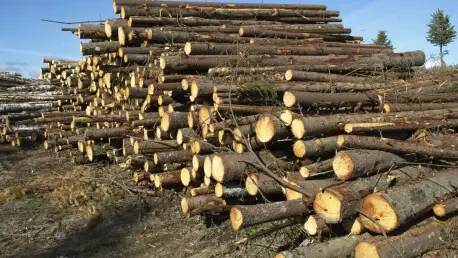In the heart of rural Zambia, a quiet revolution in energy access is unfolding, but it comes with an alarming cost to the environment that sustains these communities, particularly in regions like Mkushi, Kapiri, Mposhi, Chongwe, and Luano. Home to approximately 700,000 people, these areas have seen over one million small solar devices sold since 2018, transforming lives by lighting up homes, charging phones, and allowing children to study after dark. These advancements offer a glimmer of hope in areas with scant connection to the national electricity grid, where reliance on firewood and charcoal for cooking remains the norm. However, the financial strain of acquiring these solar systems—without government subsidies or accessible credit—has pushed families into a corner, forcing them to exploit their natural surroundings to meet payment demands. This paradox, where a clean energy solution drives environmental harm, underscores a pressing challenge that demands immediate attention and innovative solutions on both local and global stages.
The Promise and Peril of Solar Power
Energy Access and Its Benefits
The introduction of solar technology in rural Zambia has brought profound changes to daily life, particularly in remote areas far from the reach of traditional power infrastructure. Small solar home systems and lanterns have replaced hazardous kerosene lamps, which emit toxic smoke and pose significant health risks. With these devices, households can now illuminate their homes at night, enabling children to complete homework and adults to stay connected through charged mobile phones. This shift not only improves quality of life but also fosters educational opportunities and communication in communities that were once cut off after sunset. The impact is tangible, with families reporting a newfound sense of security and productivity that comes with reliable light, a basic need often taken for granted in urban settings.
Beyond individual benefits, the adoption of solar power contributes to broader public health and environmental gains by reducing indoor air pollution from kerosene. The technology offers a sustainable alternative, cutting down on carbon emissions associated with traditional fuels. In regions where over one million devices have been distributed, the cumulative effect of this transition is significant, painting a picture of progress in energy poverty alleviation. Yet, beneath this positive surface lies a complex challenge: the financial mechanisms supporting this adoption are flawed, creating unintended consequences that threaten to undermine these very benefits. The gap between access and affordability remains a critical barrier for many rural households.
Financial Barriers to Adoption
For all the promise solar power holds, the economic reality for rural Zambian families casts a long shadow over its widespread adoption. Without government subsidies or support from development finance institutions, the cost of solar systems—often paid through long-term installments—places a heavy burden on households with limited income. Affordable credit options are virtually nonexistent, leaving many unable to purchase these devices outright or manage the ongoing payments. This financial strain is particularly acute in areas where most people live below the poverty line, and the lack of tailored solutions exacerbates their struggle to integrate clean energy into their lives without falling into debt or desperation.
The absence of structured financial support means that families must often prioritize solar payments over other essential needs, creating a cycle of economic stress. Unlike wealthier households or commercial farmers who can afford upfront costs, poorer communities are left grappling with the fear of system lockouts if installments are missed, rendering their devices unusable. This precarious situation drives many to seek alternative income sources, often turning to the very forests that surround them for quick cash. The result is a troubling dynamic where the pursuit of clean energy inadvertently fuels environmental degradation, highlighting the urgent need for accessible financing models to bridge this gap.
The Environmental Cost of Clean Energy
Link Between Financing and Forest Loss
Extensive research conducted over 28 months, involving interviews with 80 individuals and 10 focus group discussions, has unearthed a distressing connection between solar financing and deforestation in rural Zambia. Over 85% of participants revealed that they fund their solar purchases by exploiting forest resources, including the production of charcoal, timber sales, and harvesting products like honey and mopane worms. Historically viewed as a natural reserve for sustenance, the forest has morphed into a financial lifeline under the pressure of monthly payments. This intensified extraction, driven by the need for consistent cash flow, has accelerated the depletion of once-abundant woodlands at a rate that alarms both researchers and community members alike.
Personal accounts from these communities paint a vivid picture of environmental loss, corroborated by geospatial data showing significant forest cover decline over the past two decades. The Miombo woodlands, known for their rich biodiversity, are described as thinned and patchy, with residents lamenting the necessity of cutting down even valuable fruit and medicinal trees to produce charcoal for wealthier buyers. The economic desperation tied to solar payments has forced a shift from sustainable practices to over-harvesting, with one charcoal burner noting the scarcity of suitable trees and the painful decision to target previously protected species. This stark reality underscores how the current financing model for solar power is undermining the ecological balance these communities depend on.
Social and Ecological Fallout
The ripple effects of deforestation in rural Zambia extend far beyond the loss of trees, striking at the heart of both ecological stability and social well-being. Environmentally, the thinning of forests disrupts local ecosystems, diminishing biodiversity and reducing the availability of wild foods and resources that sustain livelihoods. Species like mopane worms and wild mangoes, once plentiful, are becoming scarce, weakening the natural buffer against climate shocks such as droughts and floods. This degradation not only threatens wildlife but also erodes the land’s capacity to support agriculture and other vital activities, creating a cascading impact on the region’s environmental health that could take generations to reverse.
Socially, the consequences are equally severe, as the scarcity of trees transforms daily tasks into grueling endeavors, particularly for women and children who often shoulder the burden of collecting firewood. What was once a manageable chore now requires longer treks and greater effort, cutting into time for education or income-generating activities. Furthermore, the loss of forest resources heightens community vulnerability, stripping away safety nets that poorer households rely on during crises. Unlike wealthier families who can afford solar systems without resorting to exploitation, marginalized groups face a deepening cycle of hardship, trapped between the need for energy and the destruction of their surroundings. This dual toll demands urgent intervention to prevent further decline.
Gaps in Policy and Governance
Disconnected Priorities
A critical barrier to addressing the deforestation crisis linked to solar adoption in rural Zambia lies in the fragmented approach of current policies. Energy programs are heavily focused on expanding access to solar technology, often touting impressive distribution numbers as a measure of success, yet they fail to consider how rural households finance these systems. Meanwhile, forest conservation initiatives prioritize tree planting and protection without accounting for the energy needs that drive communities to exploit their natural resources. This disconnect leaves families caught in a bind, forced to navigate competing priorities with little support or guidance, resulting in outcomes that undermine both clean energy and environmental goals.
The lack of integration between these sectors is compounded by insufficient attention to the unique challenges faced by forest-adjacent communities. Solar vendors, driven by market expansion, focus on sales targets rather than affordability, while conservation agencies push reforestation without addressing the immediate financial pressures fueling deforestation. This policy gap creates a vacuum where rural households must fend for themselves, often resorting to unsustainable practices out of necessity. Bridging this divide requires a holistic framework that aligns energy access with conservation efforts, ensuring that progress in one area does not come at the expense of the other.
Accountability and Coordination Challenges
At the local level, governance issues further complicate the situation, as accountability for forest management is often blurred by conflicts of interest. Traditional leaders and officials tasked with regulating forest use are frequently involved in charcoal production themselves, undermining efforts to enforce sustainable practices. This complicity erodes trust within communities and weakens community-led conservation initiatives, allowing over-exploitation to continue unchecked. Without clear oversight or mechanisms to hold local authorities accountable, the cycle of environmental degradation persists, even as awareness of the issue grows among residents and external stakeholders.
On a national scale, the lack of coordination between Zambia’s energy and environment ministries represents a significant structural hurdle. These bodies operate in silos, with little collaboration to develop integrated policies that balance solar expansion with forest protection. The absence of unified planning means that rural energy needs are addressed in isolation from conservation goals, missing opportunities to create synergies that could benefit both sectors. Overcoming this challenge demands a concerted effort to align strategies, ensuring that clean energy adoption does not inadvertently harm the ecosystems these communities rely on for survival.
Building a Sustainable Future
Innovative Financing Models
Breaking the cycle of deforestation tied to solar adoption in rural Zambia hinges on the development of innovative financing models that reflect the economic realities of these communities. Affordable loans with low interest rates, government-backed subsidies, and flexible pay-as-you-go systems could significantly reduce the financial burden on households, allowing them to acquire solar systems without turning to forest resources for income. Tailoring payment plans to align with rural income cycles, which often fluctuate with agricultural seasons, would further ease the pressure, ensuring that families are not forced into desperate measures to meet rigid installment deadlines. Such solutions prioritize accessibility, safeguarding both energy access and environmental health.
Implementing these financial tools requires collaboration between policymakers, financial institutions, and solar providers to design systems that prioritize the needs of the poorest households. Pilot programs testing micro-credit schemes or community-based payment models could provide valuable insights into what works best in these contexts. Additionally, integrating financial literacy training could empower families to manage their resources more effectively, reducing reliance on exploitative practices. By addressing the root cause of deforestation—economic necessity—through targeted financial support, there is a real chance to create a sustainable path forward for clean energy adoption in rural areas.
Global and National Action
The upcoming global climate summit, COP30, offers a pivotal opportunity to spotlight the unique challenges faced by forest-adjacent communities in Zambia and across sub-Saharan Africa. World leaders must prioritize green energy access for these marginalized groups, who have long been excluded from national grids, by committing to targeted subsidies, micro-credit programs, and community energy schemes. Increased funding for research into the links between rural energy financing and deforestation is also essential, as it can inform evidence-based policies that prevent environmental harm while expanding clean energy. This global platform can catalyze the support needed to ensure that solar power becomes a true force for sustainability.
At the national level, Zambia’s energy and environment ministries must forge stronger partnerships to align their objectives, ensuring that solar expansion does not come at the cost of forest loss. Joint task forces or integrated policy frameworks could help bridge existing gaps, creating a cohesive strategy that addresses both energy poverty and conservation. By learning from past oversights, such as the lack of financial support in solar programs, national efforts can be recalibrated to protect vital ecosystems. Reflecting on these missed opportunities, it’s clear that coordinated action is needed to prevent the environmental toll witnessed in recent years, offering a lesson for future initiatives to prioritize balance and inclusivity.









